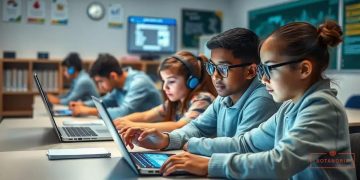Neuroeducation strategies to enhance learning outcomes
Anúncios
Neuroeducation strategies enhance learning by integrating neuroscience with education, focusing on emotional engagement and neuroplasticity to create effective teaching environments.
Neuroeducation strategies have emerged as powerful tools in revolutionizing how we approach learning.
By blending neuroscience with educational methodologies, these strategies offer insights that can enhance student engagement and retention.
Curious about how these concepts can transform your teaching practice?
Understanding neuroeducation principles
Understanding neuroeducation principles is essential for creating effective learning environments.
These principles combine insights from neuroscience and educational practices to enhance how we teach and learn.
The basics of neuroeducation
Neuroeducation aims to bridge the gap between what we know about the brain and how we can improve learning experiences.
By studying brain functions, we can tailor our teaching methods to better suit the way students learn.
Key concepts in neuroeducation
- Neuroplasticity: This is the brain’s ability to reorganize and adapt itself based on new experiences, which is crucial for effective learning.
- Multi-sensory learning: Engaging multiple senses can significantly enhance retention and understanding of information.
- Emotional impact: Emotions play a significant role in learning. Positive emotional environments can promote better engagement.
- Active learning: Involving students in their learning process through discussions and hands-on activities fosters deeper understanding.
These concepts highlight the necessity of adopting new methods that resonate with how our brains work.
Teachers who understand these principles can create more personalized and engaging learning experiences.
Furthermore, incorporating neuroeducation strategies can lead to improved outcomes. For instance, teachers who implement strategies based on neuroscience find that their students are more engaged and retain information better. It’s not just about what is taught, but how it is taught.
By focusing on brain function and learning habits, educators can enhance creativity in the classroom, making learning more enjoyable for students.
This approach encourages curiosity and discovery, essential elements in nurturing a lifelong love of learning.
Incorporating these principles into everyday teaching practices can transform traditional education, making it more responsive to individual needs.
As educators begin to understand and apply neuroeducation principles, the potential for creating effective learning environments expands dramatically.
How neuroplasticity affects learning

Neuroplasticity is a fascinating concept that underlies how we learn and adapt. It refers to the brain’s ability to change and reorganize itself throughout a person’s life.
This capability is crucial for developing new skills and adapting to new experiences.
The role of neuroplasticity in learning
When we learn something new, the connections between brain cells strengthen.
This phenomenon is what allows us to retain information and perform tasks more effectively.
The more we practice, the stronger these connections become.
Types of neuroplasticity
- Functional plasticity: This type refers to the brain’s ability to move functions from damaged areas to other undamaged areas.
- This is especially important after an injury.
- Structural plasticity: This involves physical changes in the brain, like forming new connections or even growing new neurons.
- Experience-dependent plasticity: This occurs when experience shapes brain structure and function significantly, impacting learning.
- Synaptic plasticity: This is the process by which synapses strengthen or weaken over time, allowing for memory formation and learning.
Understanding how neuroplasticity affects learning can empower both educators and students.
By fostering an environment that encourages practice and exploration, learning becomes more effective.
For instance, when students engage in repeated activities, the brain acknowledges these tasks as important, enhancing their learning process.
Furthermore, emotions can influence neuroplasticity.
Positive emotions often promote greater motivation and engagement, which leads to better learning outcomes.
When students feel happy and enthusiastic, their brains are more likely to absorb new information.
To harness the power of neuroplasticity, educators should include diverse teaching strategies that challenge students.
This variety can stimulate different areas of the brain, promoting richer learning experiences.
As learners continue to grow, embracing neuroplasticity ensures that education is a dynamic and evolving process.
Practical neuroeducation strategies for teachers
Implementing practical neuroeducation strategies can significantly enhance teaching effectiveness.
These strategies help educators create learning environments that align with how the brain processes and retains information.
Engaging multiple senses
Using multiple senses during lessons can boost engagement and retention.
When students see, hear, and touch materials, their learning becomes more immersive.
For example, incorporating visuals, sounds, and hands-on activities encourages deeper understanding.
Cultivating a positive emotional climate
- Supportive environment: Foster an atmosphere where students feel safe to express themselves.
- Positive feedback: Encourage students with constructive feedback to build confidence.
- Mindfulness practices: Integrate short mindfulness exercises to help students manage stress and improve focus.
- Collaborative learning: Promote teamwork, allowing students to learn from each other.
These elements not only support emotional well-being but also enhance the learning experience.
Students who feel valued and connected are more likely to engage with the material.
Additionally, using technology effectively can transform lessons. Interactive apps and online resources can make learning more engaging.
For instance, educational games allow students to practice skills in a fun and low-pressure environment.
This aligns well with neuroeducation principles, as it keeps the brain active and engaged.
To further implement neuroeducation strategies, teachers can design lessons around real-life experiences.
Contextual learning helps students relate what they learn to their daily lives.
By seeing the relevance of their education, students are more motivated to learn.
Finally, regular assessment and reflection are crucial.
Educators should encourage students to reflect on their learning processes.
This practice promotes metacognition, helping students understand how they learn best and how to set achievable goals.
The role of emotions in learning

Emotions play a crucial role in learning. When students experience positive feelings, they are more likely to engage with the material.
This connection between emotions and learning impacts how effectively we absorb and retain information.
Understanding emotional impact
Negative emotions can hinder learning. Students who feel anxious or frustrated may struggle to focus and absorb information.
On the other hand, a supportive environment that promotes positive emotions can enhance learning experiences.
Creating a positive emotional climate
- Encourage open communication: Create an atmosphere where students feel safe to express their feelings and concerns.
- Celebrate achievements: Recognizing and celebrating small successes can boost students’ confidence and motivation.
- Incorporate social-emotional learning: Teach students about emotions and how to manage them effectively.
- Use engaging materials: Incorporate stories and activities that evoke positive emotions to make learning more relatable.
By fostering a positive emotional climate, educators can help students develop resilience.
When they feel supported, students are more willing to take risks in their learning journey.
Moreover, engaging with emotions through lessons can enhance memory retention.
For example, stories that connect to students’ feelings are often remembered better than mere facts.
This approach taps into the brain’s natural wiring, reinforcing the idea that emotional connections enhance learning.
Lastly, incorporating mindfulness practices can help in managing emotions.
Brief mindfulness exercises in the classroom can calm anxious minds, making it easier for students to focus on learning.
By allowing students to explore their feelings, they can better understand how emotions affect their learning process.
Evaluating the impact of neuroeducation
Evaluating the impact of neuroeducation is essential to understanding how effective these strategies are in improving learning outcomes.
By assessing various methods, educators can determine what works best for their students.
Measuring academic performance
One way to evaluate impact is by analyzing students’ academic performance over time.
This can involve comparing test scores before and after implementing neuroeducation strategies.
Observing improvements in grades can give insight into the effectiveness of these methods.
Gathering feedback
- Student surveys: Collecting feedback from students about their learning experiences can highlight areas where neuroeducation has made a difference.
- Teacher observations: Educators can observe changes in student engagement and participation when using neuroeducation techniques.
- Parent input: Parents can provide valuable feedback on their children’s attitudes toward learning at home.
- Peer assessments: Encouraging students to assess each other’s work can foster a deeper understanding of learning impacts.
Feedback from various stakeholders can provide a comprehensive view of the changes in the classroom environment and how neuroeducation methods are received.
Another important aspect of evaluating the impact involves studying social-emotional outcomes.
When students are happier and feel more connected, it can lead to improved academic performance.
Surveys and assessments that focus on students’ emotional well-being can highlight this relationship.
Moreover, it’s essential to monitor retention rates.
If students are sticking with their studies and expressing a desire to learn, this can indicate that neuroeducation strategies are resonating with them.
Incorporating system-wide evaluations can also be beneficial. Schools implementing neuroeducation strategies across various grades can analyze overall changes in the educational setting. Tracking long-term trends can provide insights into how these methods impact not only individuals but the broader school community.
FAQ – Frequently Asked Questions about Neuroeducation
What is neuroeducation?
Neuroeducation is an approach that combines neuroscience and education to improve teaching methods and learning experiences.
How does neuroplasticity affect learning?
Neuroplasticity allows the brain to adapt and change based on new experiences, which is essential for learning and retaining information.
Why are emotions important in the classroom?
Emotions play a crucial role in learning; positive emotions can enhance engagement and retention, while negative emotions may hinder progress.
How can teachers evaluate the impact of neuroeducation strategies?
Teachers can assess the impact by analyzing academic performance, gathering feedback from students, and observing social-emotional outcomes.





